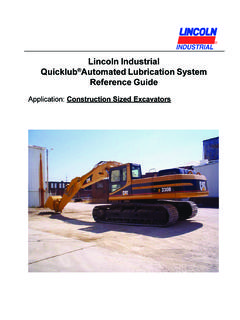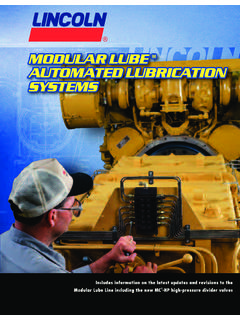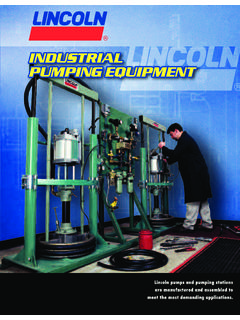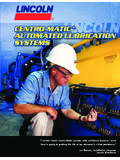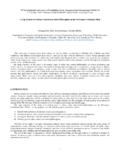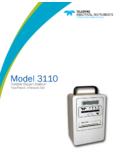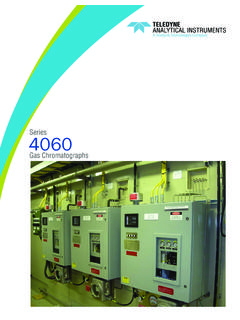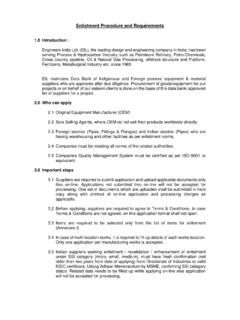Transcription of 41 oil mist application manual - Lube Systems of California
1 Alemite Oil MistApplication ManualIntroductionThe Oil Mist principle was developed in the late 1930 s by aEuropean bearing manufacturer. The problem that nurturedthis development was the inability to satisfactorily lubricatehigh-speed spindle bearings on grinders and similarequipment. The speeds of those bearings were too high forgrease lubrication, and the heat generated by fluid friction inliquid oil necessitated the use of costly re-circulatingsystems. Continuous thin-film lubrication with Oil Mistprovided a solution, and the purging of bearing housings thataccompanies this lubrication produced additional Corporation purchased the rights to Oil Mistin 1949.
2 Since then, the Alemite Corporation has developeda broad line of equipment and application techniques tolubricate all kinds of machine elements, from the tiny, ultra-high-speed parts of dentists drills to the huge gears andbearings of steel rolling mills. With modern demands formore and more complex machines running at higher andhigher speeds, and for greater reliability and economy, thelist of applications for Alemite Oil Mist Systems grows longerand it doesOil Mist lubrication is an automatic, centralized system thatCONTINUOUSLY delivers fresh, clean oil to multiple, andoften widespread, machine elements. There are numerousadvantages to Oil Mist, in addition to the improvements insafety, productivity, housekeeping, and lubrication that areachieved by automatic centralized Systems in delivery, at rates closely approximating actualbearing-surface needs, eliminates the overlubrication that isnecessary to insure adequate supply between periodicapplications.
3 LUBRICANT CONSUMPTION can often bereduced by as much as 80%.In many cases, continuous lubricant delivery by Oil Mistpermits elimination of energy-wasting oil sumps. Reductionsin POWER consumption of more than 25% are TEMPERATURES are often lowered dramatically,not by actual cooling, but because most of the powerconsumption reduction represents heat that is not generatedin churning excess of housings, with continuous outward air flow,extends MACHINE LIFE by helping to exclude dirt andcorrosive atmospheres. Oil Mist is even used to protectequipment on standby and in it does itThe heart of the system is the mist generator. Air fromnormal factory air supply passes over a venturi inside thegenerator, which accelerates the flow.
4 This creates lowpressure and high velocity at the venturi discharge. As airpasses through the venturi it draws oil from the generatorreservoir into the high velocity air stream. The combinationof low pressure and high impact explodes the oil into tinyparticles. This mist is then thrust against a baffle that collectsand drops larger particles back into the reservoir. Thelighter, airborne particles are then carried by the air streamthrough the distribution system to the various points efficiency of an Oil Mist System is dependent uponvarious designed lubrication fittings that serve as contactpoints to the parts to be lubricated. These fittings serve twofunctions.
5 They maintain balanced pressure in the systempreventing over or under lubrication of a bearing. Theyregulate the amount of mist through the fitting orifices into thebearings being to apply itBASIC STEPS TO DESIGN AN ALEMITEOIL MIST SYSTEM1. DESCRIBE each element to be lubricated andCALCULATE its Oil Mist flow requirement in CUBIC FEETPER MINUTE (CFM).2. Select application FITTING TYPES and determinetheir PLACEMENT and VENTING Select the DESIGN MANIFOLD PRESSURE (DMP).4. Determine FITTINGS Select an appropriate Oil Mist ROUTE and SIZE air and mist distribution Select FITTNGS CONFIGURATIONS that will be mostconvenient to install and connect to distribution Select Plan ELECTRICAL Mist Application1 Details of basic steps -General:For all DESCRIPTIONS required to CALCULATE the mistrequirements of machine elements include type of element,dimensions, and various details of installation andoperation.
6 This information is used in simple formulas tocalculate cfm of mist required. The formulas are based onthe design standard oil/air ratio of cubic inch ( ) per hour per cfm. They assume that the elementsto be lubricated were properly selected for the intendedservice and properly assembled and protected fromcontamination. They also assume the use of an oil with theproper misting and lubricating qualities for the intendedapplication. (FORMULAS and other considerations forapplying Oil Mist to SPECIFIC TYPES OF MACHINEELEMENTS are given in a later part of this manual :PAGES 6-10.) FITTING TYPESFITTING SELECTIONS are primarily based on the types ofelements to be lubricated, but are often influenced by otherfactors, such as machine configuration or speed.
7 Ingeneral, use SPRAY FITTINGS and SPRAY NOZZLES forROLLING MOTION elements, such as anti-frictionbearings, gears and chains. (SPRAY NOZZLES are justmultiples of the largest Alemite spray fitting.)CONDENSING FITTINGS or SPRAY FITTINGS are usedfor SLIDING MOTION elements, such as plain bearings,slides, and ways. MIST FITTINGS are used only for rollingelement bearings operating in closed housings, underparticular types of loading, and above a minimum PLACEMENTPLACE SPRAY FITTINGS to discharge close to thelubricated elements, preferably less than one inch POSITIONING of spray fittings is permissible iftheir outputs are ducted to and flow through the lubricatedelements because of relative positions of fittings and vents,and if passages downstream from the fittings are horizontalor sloped downward toward the SPRAY DIRECTLY on elements moving at speeds upto about 1600 linear feet per minute.
8 Keep spacing betweenspray fittings and moving surfaces under 1/20 inch per inchwater column manifold pressure. At higher speeds, installspray fittings 1/8 to 1/4 inch from the moving surfaces anduse higher mist pressures-40 in. H20 above 2000 lfm andup to 80 in. H20 at much higher CONDENSING FITTINGS the oil flows by gravitydirectly to the grooves supplying the sliding surfaces. Thefitting location should be as close to the grooves FITTINGS may be installed in any location, providingthe mist flow envelops or passes through the elements tobe DISCHARGE DIRECTIONSPRAY and CONDENSING FITTINGS work most efficientlywhen discharging downward. However, discharge may be inany direction BETWEEN DOWNWARD AND FITTINGS may also be installed to dischargeUPWARD, in which case the CALCULATED CFM used toselect fittings sizes should be discharge should be approximately perpendicular tothe direction of motion of the sprayed FITTINGS may be installed to discharge in must be provided for the escape of carrier air fromclosed VENT AREA is equal to twice the total flow area ofthe application fittings supplying flow to that vent.
9 Vent areasof this size will produce housing back pressures equal toabout 20% of manifold possible, relative POSITIONS of VENTS, application FITTINGS, and LUBRICATED ELEMENTS should produce forced flow from application fittings tolubricated can be by means of approximately locatedDRILLED HOLES or, frequently, by existing ports in thehousing. LABYRINTH SEALS will usually provide adequateventing, although a small one might have insufficientclearances for this purpose, and require the addition of adrilled hole. CONTACT SEALS can be notched to provideventing, but this is not recommended because of thelikelihood that notching will not be provided when seals PORTS can often serve as OIL OVERFLOW ORDRAIN ports.
10 In an oil-sump application the vent can beplaced just above the normal sump oil level to provide anoverflow path for any excess oil delivered by the Oil Mistsystem. Such vents should be located so that liquid oil willnot splash out through the port. For a dry-sump applicationthe vent can be placed at the bottom of the housing to drainall should generally be PROTECTED from outsidecontaminants. Holes in the sides of housings should slopedownward to the outside. Vent ports in the tops of housingsshould have shielded vent fittings DESIGN MANIFOLD PRESSURE (DMP) is the pressuredrop across the application fittings at which the fittings sizesare selected. It is the intended output pressure of the Oil Mistgenerator.



